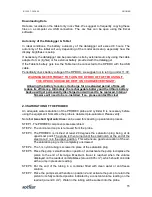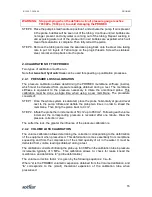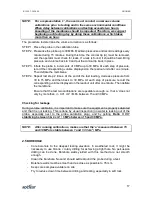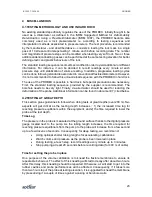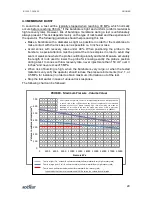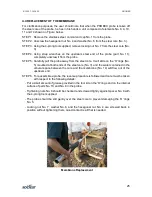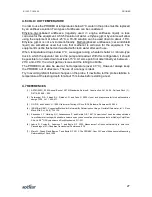
17
E10037-180424
PROBEX
NOTE:
For a representative
‘c’, the user must conduct numerous volume
calibrations prior to testing and in the same environmental conditions.
When delay between calibrations and testing exceeds two hours,
kneading of the membrane should be repeated. Therefore, we suggest
beginning each testing day by doing these calibrations, which takes
more than an hour.
The procedure to determine the volume correction is as follows:
STEP 1. Place the probe in the calibration tube.
STEP 2. Pressurize the probe up to 30 MPa. Maintain pressurize and record readings every
minute during 15 minutes. During this time, the conical tip (A) must be removed,
and the operator must check for leaks. If a leak is found, it should be fixed. Bring
pressure and volume back to 0 and put the conical tip back in place.
STEP 3. Inflate the probe in increments of 3 MPa up to 30 MPa. At each step of pressure,
record the corresponding volume displayed on the readout unit after one minute.
Then deflate the membrane.
STEP 4. Repeat last step 2 times. At the end of the last loading, decrease pressure from
30 to 15 MPa and then back to 30 MPa. At each step of pressure, record the
corresponding volume displayed on the readout unit after one minute. Then deflate
the membrane.
Ensure that the last two calibrations are repeatable enough i.e.
that ‘a’ does not
vary by more than +/- 0.01 cm
3
/ MPa between 15 and 30 MPa.
Checking for leakage
During volume calibration, it is important to make sure the equipment is properly saturated
and that it is not leaking. This is done by visual inspection (no water is leaking out of the
probe, especially next to the probe saturation plug), and by getting
‘Delta V CC’
stabilizing between 3 & 4 cm
3
/ 3 MPa between 15 and 30 MPa.
NOTE:
After running calibrations, make sure that the ‘a’ measured between 15
and 30 MPa is stable between 1 and 1.33 cm
3
/ MPa.
2.5
BOREHOLE
-
Core borehole to the deepest testing elevation. In weathered rock, it might be
necessary to use t rotary drilling for achieving a tight hole. No percussion
drilling can be done. Borehole walls yielded with this method are not smooth
enough.
-
Clean the borehole. No sand should settle around the probe during a test.
-
Borehole walls must be smooth and as close as possible to 76 mm.
-
Keep core samples available on site
-
Try to reduce down time between drilling and testing, especially in soft rock
.













